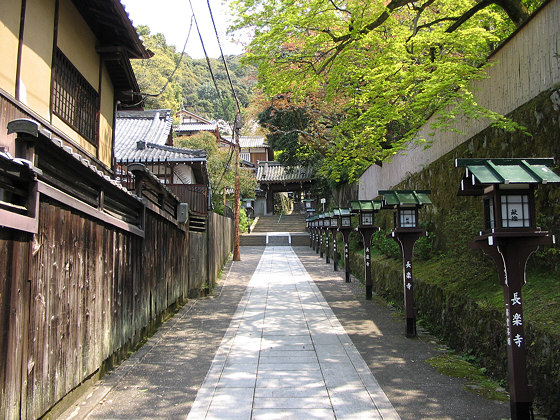Choraku-ji Temple, Kyoto
Chorakuji Temple is where Kenreimon-in, daughter of Taira Kiyomori and mother of Emperor Antoku, took the tonsure in 1185 after the defeat of her clan by the Genji at the battle of Dan no Ura. These events are described in the epic The Tale of the Heike.

The main hall and belfry of Chorakuji temple.
The temple was founded at the Emperor Kammu's behest in 805 by Saicho (767-822), posthumously known as Dengyo-daishi, and
has been much respected by emperors. The principal image is Kannon Bosatsu (Avalokitesvara). In accordance with the
Imperial ordinance, it was not open to the public, and could be seen only in special years, such as when an enthronement
ceremony was held and special years called "yakudoshi" under supervision of an Imperial emissary.
Chorakuji temple used to belong to the Japanese Tendai sect in the Heian period (794-1191). However, at the beginning of
the Kamakura period (1192-1333) Ryukan-risshi admired Honen-shonin, the founder of the Jodo sect, and left Mount Hiei to stay at this temple and found the Senshu Nenbutsu Chorakuji School. During the
Muromachi period (1338-1573), this temple was transferred to Kokua-shonin, whose sect was the Jishu, which was founded by
Ippen shonin at the end of Kamakura period. Finally Konko-ji Temple, which was the principal temple of the Jishu sect,
was combined with this temple in 1876.

Path leading to Chorakuji temple.
In 1185 the Taira clan (the Heike) suffered an annihilating defeat at the hands of the Minamoto clan (the Genji) in the
Battle of Dannnoura. Kenreimonin, the mother of the Emperor Antoku and a daughter of Taira no Kiyomori, was embraced by
this temple and took the tonsure by Insei-shonin. To say mass for the Emperor who died at the age of eight, Kenreimonin
herself made special flags for offering to this temple out of the clothes he was wearing at the time of his
death.
Kenreimonin joined this temple as a nun when she was 29 years old. In general, old portraits rarely exist so the
temple's portrait is a precious historic artifact. It seems that the surface of the portrait was covered with an
ink-like substance in order to deceive the enemy, the Genji Clan, and thus save the portrait from destruction at their
hands.
The Hotei statue, which is one of the Seven Deities of Fortune made by Shoichi-kokushi at the beginning of the Kamakura
period, has been kept for about 800 years despite the fact that it was made of fragile unfired mud. Copies of the Hotei
image were provided to the old families of Kyoto to people who wanted to help them smile despite the ongoing battles. The
Hotei in this temple is popular because of his unpretentious warai (smile).

The main hall and belfry of Chorakuji temple.


